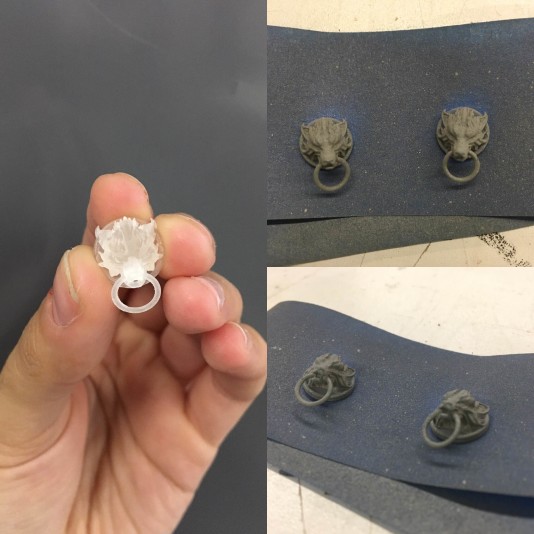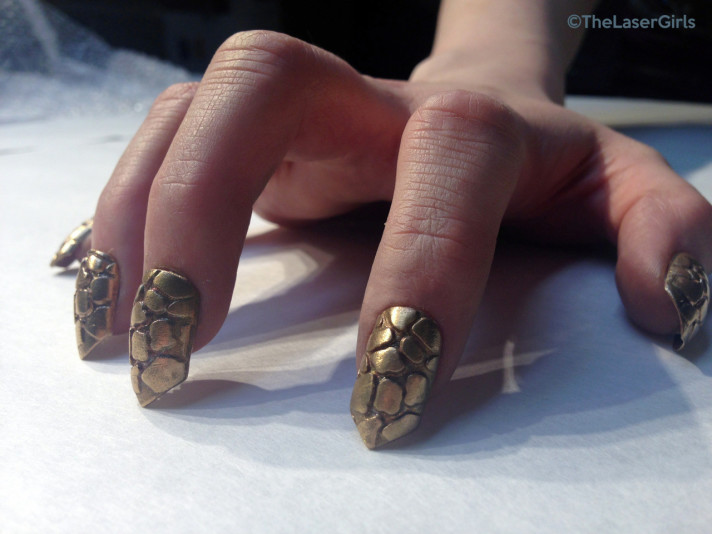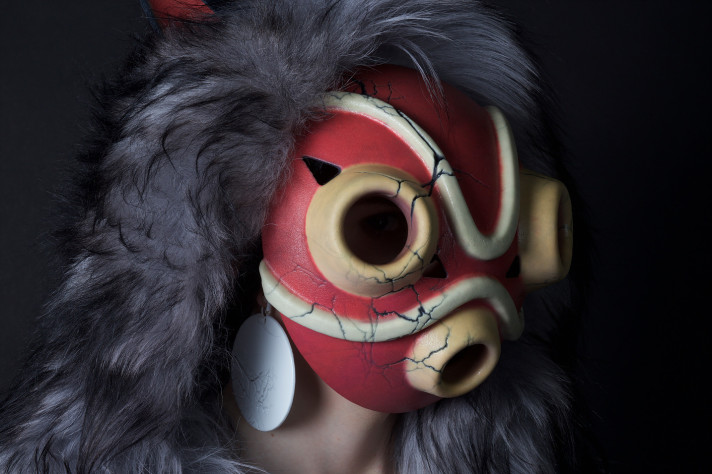
- The lasergirls have designed some of our favorite fashion and cosplay items, and we’ve been running a series of blog posts with their tips on using Shapeways to design for cosplay. Below are their recommendations for using Shapeways materials.
Convention’s are always in season, and with New York Comic Con just around the corner, you may have been inspired to hop on the cosplay train.
3D printing cosplay is a great project for those of you either looking for a fresh new challenge, or if you are just starting out, since the processes of printing and modeling are so scalable and versatile.
Before getting started though on your 3D Printed Cosplay Journey, be sure to review your event’s weapons policy and make sure that your creation fits within any size, material, and/or safety regulations. Use the same discretion and sense of context (as we mentioned in our last CCC post) when choosing printed materials. Make sure to review the MSDS, Food Safe policies, and other disclaimers on materials you plan to use.
And with that, let’s dig in!

Rings printed in Frosted Ultra Detail, then primed for painting
Frosted Ultra Detail (FUD) and Frosted Extreme Detail (FXD)
FUD/FXD has many elements that could make it a cosplayer’s dream: the clear, smooth surface is easy to paint, its lightweight nature makes it more practical from a wearable point of view, and its lower price point means you can print more pieces to test on or iterate design. In regards to detail, the name speaks for itself; the strikingly high resolution is unique to other materials, even down to half a pea-size.
Another huge plus to using this material is the dedicated community surrounding it; primarily used by model train and miniature artists, there is a vast amount of content centered around finishing and post production at a truly masterful, borderline perfection sort of way. Its power really lies in being a precision material, so if you are looking to replicate something exactly, FUD/FXD may be a good fit.
However, the extremely disappointing con to using this material is the maximum bounding box dimensions, or the maximum size object you can print. For FUD, it is a mere 11X 7 X 8 inches and FXD, even smaller at 2 X 2 X 8 inches, which cuts down on what you can use it for.
But for those special, smaller pieces that really need to make a statement, this material can pack a punch. As mentioned before, its level of detail makes it great for replicas and pertinent complex details. It can also be used as an alternative for jewelry pieces if metal and steel are not in your budget, since it is easy to paint. If you are working with LEDs or other lighting in you cosplay, FUD/FXD’s semi transparent material can be used in its raw form as orbs, pendants, or other pieces that need light to pass through them-just make sure your light does not burn too hot, for this material will warp by heat!
In a Nutshell:
Best for: Filigree, keychains, jewelry, small replicas,
Examples: Cersei’s pendant, Final Fantasy VII Materia, Elsa’s hairpins
Resolution: High to Extreme
Pros: Easy to paint, can print more delicate parts, large community surrounding it
Cons: Orientation not guaranteed, mild skin irratant, Small bounding box, Dries and becomes flaky quickly, no flex, very un-archival if not maintained

3D printed nails in various Strong and Flexible colors
Strong and Flexible Plastic
Shapeways’ most popular material, the Strong and Flexible family provides cosplayers with a great base for larger scale pieces in a crisp rainbow of shades. With a print platform of 25 X 13.7 X 21.6 inches, scale is fairly limitless, and combined with its lightweight nature that exhibits a bit of flex, SF is a great option for those larger armor pieces and weapons. Headpieces, such as crowns and hair clips are also perfect for this material due to that flex. The material also comes in both a polished and unpolished finish, so if you are looking for either something more streamlined or something with a hint of texture, you have options. The dyed colors are bright but flat, making them great bases for further finishing/weathering, or for those more cartoon-like interpretations.
Going with color though brings up some potential issues: the dying process only penetrates the material with color to a certain thickness, meaning that the majority of your model is white. With that, be careful if you are sanding or carving into those materials, for if you cut too deep you will hit a white core. The dyed SF is also only available in polished, meaning you will have to dye the pieces on your own if you are looking for a different surface quality. And although that sounds like a ton of work, SF is widely known to be easily dye-able (the popular recommendation is RIT dye, accessible, safe and inexpensive).
On the subject of finishing, it is important to be mindful SF’s porousness, which is great for dyeing, but may not be ideal for hand painting or spray painting without a bit of prep beforehand to prevent feathering. bunching, or unevenness. We recommend for acrylics. Fine details as well may also get washed out by the texture of the material, so model with design and material intent.
With all that said, if you are making body armor, weapons, staffs, and other grander scale pieces that require a practicality and streamlined surface, SF is the perfect base, and with the right finishing, can become . As a cost cutter, print your main, larger pieces in SF then inserting or adding atop of that base with other filigree printed in other materials, like steel or even PLA.
We would not recommend direct to skin contact with SF, for its sandy film can be irritating to your dermis; instead, either line the piece with a fabric, or wear an undergarment as a barrier.
Prototype for a Bridal Comb Sarah made in Strong and Flexible Plastic; Check out the finished (metal and SF) product here!
In a Nutshell:
Best For: Armor, headbands, bracelets and bracers, masks
Cosplay Examples: Lightning Returns’ shield, Opal’s Bow/ Arms (Steven Universe), Princess Zelda’s crown
Resolution: Medium to High
Pros: easy to dye, lightweight, durable, slightly flexible, larger print platform, smooth surfaces
Cons: Rough texture, not certified skin safe, painting can be hit or miss if not properly prepped

Pyrite brass nails
Precious Metals and Steel
From nickel to gold to platinum, Shapeways has a large pool of options for steel and metals . This variety gives cosplayers a number of looks to choose from. With a maximum bounding box of roughly four inches, exceptionally large pieces are out, but for those pertinent jewelry-sized replicas, you can’t really beat this .
The most important aspect of 3D printed metals to be mindful of when modeling is their shrinkage rates; as the materials heat and cool throughout their creation, they will change in size. Shapeways does have those tolerances listed on the material description pages, so make sure to model with these in mind, especially if they are being worn or inset into other pieces.
Obviously some of Shapeways most expensive offerings, these materials are best suited for those special, meaningful elements, but could also beautifully elevate armor, crowns, and weapons as insets or decorative flourishes.
In a Nutshell:
Best for: hardware, jewelry, decorative inserts/small details
Resolution: Medium to High
Examples: Star Trek insignia, Power Ranger Power Coins, Sailor Moon jewelry,
Pros: Durable, weighty, “real thing”
Cons: Be aware of skin allergies, price , Striations in steel, high maintenance (precious metal and plated metals)

Mask, Full Color Sandstone, photo by Joanne Lee
Full Colored Sandstone
Full Colored Sandstone is a beautiful material; its textural finish combined with the printer’s 255 color capability makes it a great choice for pieces that need to have a “handmade” look to them or a less industrial finish that plastic can generate. Full color sandstone can even be made watertight if coated with resin afterwords; this process also gives the material a nice surface finish.
In general, we would recommend this material for those who need to print large, complex and full color pieces, which is why Dhemerae chose it for her Princess Mononoke mask. Masks in general, tend to have a handmade look to them which is why they’re so great when printed in this material. Sandstone would also be great for carvings and engravings on hilts for weapons and even headpieces. Sandstone is also very affordable compared to some of the materials.
Keep in mind though, this material is quite brittle. Among the more delicate of 3D printed materials, Sandstone will shatter if dropped, bleach if touched by water, and alter color under certain lighting condition (i.e. if it is left out the sun or under a UV light, the color will change). However all Sandstone prints are treated to a Cyanoacrylate bath to bring out the color and make the print more durable. But obviously, you still want to treat these prints with some extra TLC.
Regarding color, flat, primary colors will print most accurately to what you see on the computer, but be aware that you will most likely not have a perfect color match. If you are printing with a flesh or red toned palette, we recommend doing color tests, since these tones are the most difficult for the printer to execute.
Full Colored Sandstone is still a great material for cosplay, if utilized strategically and handled particularly. For those focal point pieces and elements that will not be at the center of a ton of action, this material will shine, and has the potential to elevate your cosplays in a unique way.
In a Nutshell:
Best For: small props/familiars, masks, pendants
Examples: Link’s Ocarina, Tobi’s Mask, Sprited Away bath tokens
Resolution: Low to Medium
Pros: Look and Texture, prints directly in color, potentially less finishing (depending)
Cons: UV sensitive, color bleaching upon water contact, delicate/shatters easily, price


